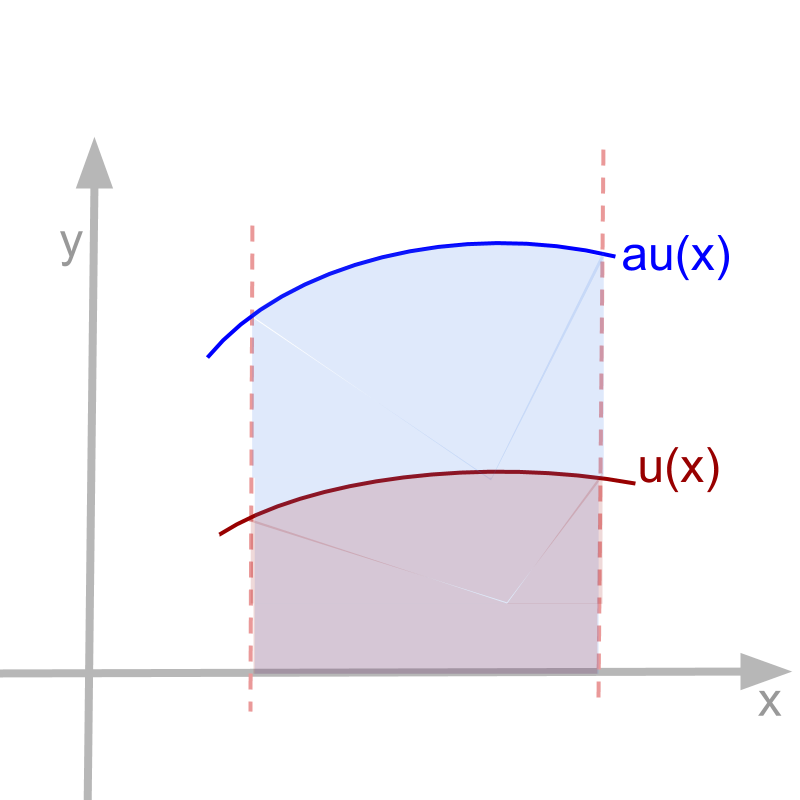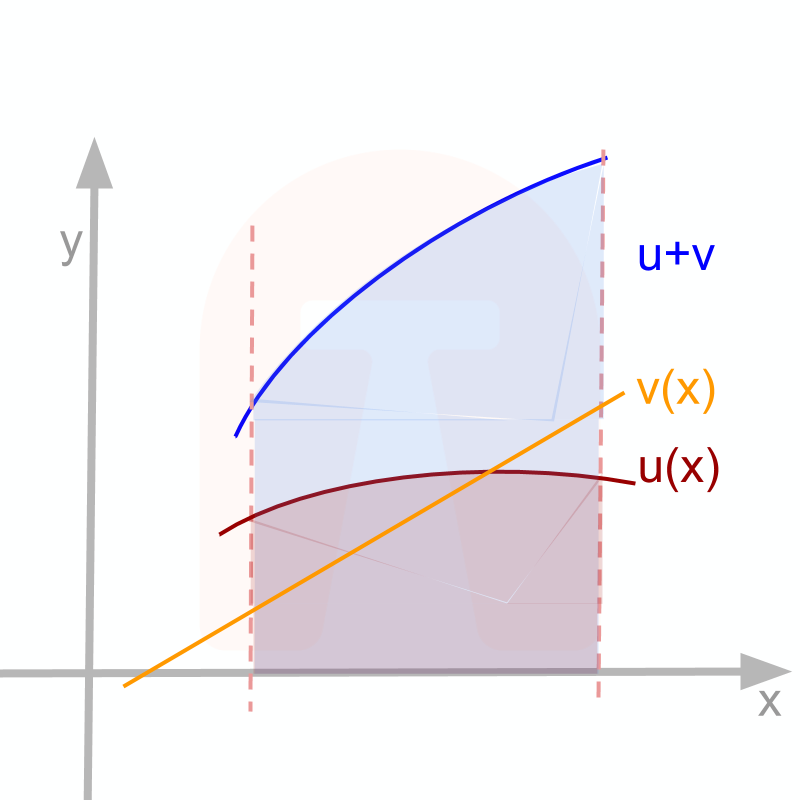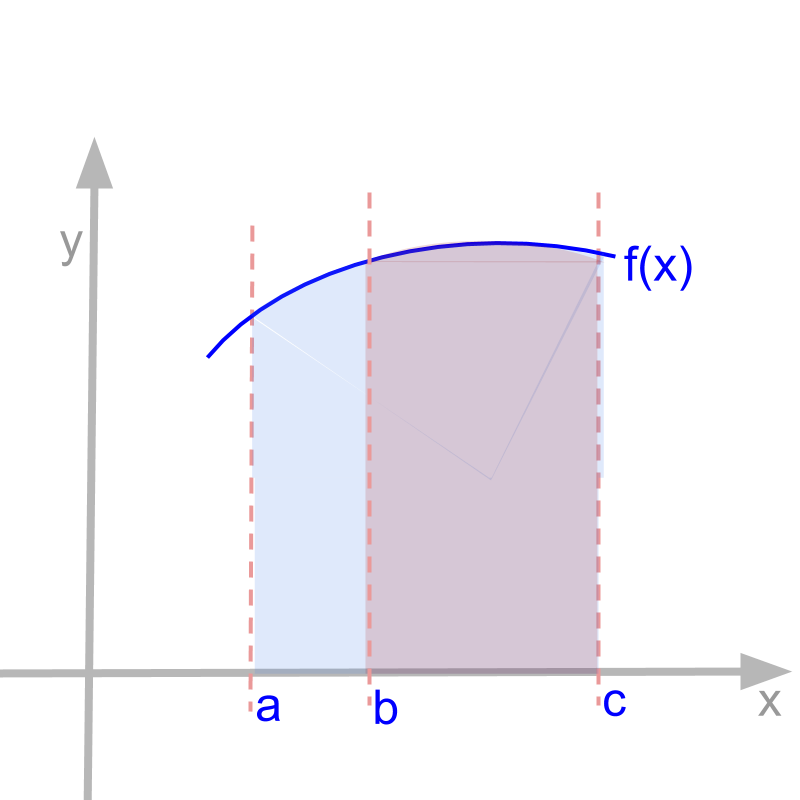
what you'll learn...
Overview
» Understanding Algebra of Integrals
how integral applies to a function given as algebraic operations of several functions
→ addition and subtraction
→ product and division
→ function-of-function
→ parametric form of function
» Indefinite integrals under Basic Arithmetic Operations
→ ∫audx=a∫udx∫audx=a∫udx
→ ∫(u+v)dx=∫udx+∫vdx∫(u+v)dx=∫udx+∫vdx
→ ∫(u-v)dx=∫udx-∫vdx∫(u−v)dx=∫udx−∫vdx
» Properties of definite integrals
→ ∫baf(x)dx=∫baf(y)dy∫baf(x)dx=∫baf(y)dy
→ ∫aaf(x)dx=0
→ ∫baf(x)dx=-∫abf(x)dx
→ ∫baf(x)dx +∫cbf(x)dx=∫caf(x)dx
algebra is about operations + - * / ^
What does the title "Algebra of Integration" or "Algebra of Integrals" mean?
The mathematical operations are
• addition and subtraction u(x)±v(x)
• multiple of a function au(x)
• multiplication and division u(x)v(x) and u(x)v(x)
• powers and roots [u(x)]n and [u(x)]1n
• composite form of functions v(u(x))
• parametric form of functions v=f(r);u=g(r)
establishing the problem
Given that f(x)=u(x)⋆v(x) where ⋆ is one of the arithmetic or function operations.
Will there be any relationship between the integrals of the functions ∫u(x)dx ; ∫v(x)dx and the integral of the result ∫f(x)dx?
Algebra of integration analyses this and provides the required knowledge.
Note: In deriving the results, the functions are assumed to be continuous and integrable at the range of interest. For specific functions at specific intervals, one must check for the continuity and the integrability before using the algebra of integrals.
example problem
For example, consider
u(x)=x2
v(x)=sinx
f(x)=x2sinx
From the standard results, it is known that
∫x2dx=x33+c and
∫sinxdx=-cosx+c.
What is ∫x2sinxdx?
In this particular example multiplication is considered. Instead of multiplication, one of the arithmetic or function operations may be considered too.
The algebra of integrals analyses this and provides the required knowledge to solve.
indeginite integral : 3 forms
Indefinite integral or anti-derivative is defined as ∫f(x)dx=g(x)+c, where g(x) is one of the following
• continuous-aggregate represented by limn→∞n∑i=1f(ixn)×xn
• anti-derivative found as ddxg(x)=f(x).
• the area under the curve f(x) between 0 and x.
To understand the properties of indefinite integrals one of these is used.
• continuous aggregate provides rigorous mathematical proof.
• anti-derivatives provide proof derived from properties of derivatives.
• area under the curve provide the geometrical methods.
A proof given in one of these three can be verified in other.
scalar multiple
Integral of a scalar multiple of a function: Given v(x)=au(x).
∫vdx
=limn→∞n∑i=1(v(ixn)xn
=limn→∞n∑i=1(au(ixn)xn
with continuity and integrability conditions on u
=alimn→∞n∑i=1(u(ixn)xn
=a∫udx
The above proves
∫avdx=a∫vdx
integral of a multiple of a function is multiple of the integral of the function

Intuitive understanding for
∫audx;=a∫udx
• continuous aggregate multiplies when the function is multiplied by a constant.
• area under the curve multiplies when the y values of curve is multiplied.
Given ∫ydx=2x2 and v=y5, what is ∫vdx?
The answer is "25x2"
∫vdx
=∫y5dx
=15∫ydx
=15×2x2
=25x2
sum or difference
Finding integral of sum or difference.
∫(u+v)dx
=limn→∞n∑i=1(u(ixn)±v(ixn))×xn
=limn→∞n∑i=1u(ixn)×xn±v(ixn)×xn
with continuity and integrability conditions on u and v
=limn→∞n∑i=1u(ixn)×xn
±limn→∞n∑i=1v(ixn)×xn
=∫udx±∫vdx
The above proves
∫(u+v)dx=∫udx+∫vdx
∫(u-v)dx=∫udx-∫vdx
integral of a sum or difference is the sum or difference of integrals.

Intuitive understanding for
∫(u±v)dx=∫udx±∫vdx
• continuous aggregate adds (subtracts) when the function is added(subtracted).
• Areas under the curves add (or subtract) when the functions are added (or subtracted).
Given ∫udx=sinx and ∫vdx=x+20, what is ∫(u+v)dx?
The answer is "sinx+x+20"
summary
Integral of a Multiple:
∫(au)dx=a∫udx
Integral of Sum or Difference:
∫(u+v)dx=∫udx+∫vdx
∫(u-v)dx=∫udx-∫vdx
Note: Other algebraic operations (like multiplication, function of function, etc.) will be taken up in due course.
Definite integral : 3 forms
Definite integral is defined as ∫baf(x)dx=g(b)-g(a), where g(x) is found by either one of the following
• continuous-aggregate represented by limn→∞n∑i=1f(a+i(b-a)n)×b-an
• the anti-derivative of f(x) represented by ddxg(x)=f(x).
• the area under the curve f(x) between a and b.
To understand the properties of definite integrals one of these is used.
• continuous aggregate provides rigorous mathematical proof.
• anti-derivatives provide proof derived from properties of derivatives.
• area under the curve provide the geometrical methods.
A proof given in one of these three can be verified in other.
definite and indefinite
It is noted that anti-derivatives or indefinite integrals can be used to compute definite integrals.
The properties pertaining to addition, subtraction, and multiplication by constant are studied for indefinite integrals. Those are be directly applicable to definite integrals.
change in valriable
Consider two forms of definite integrals.
∫baf(x)dx=g(b)-g(a) and ∫baf(y)dy=g(b)-g(a).
The left hand side has different variables x and y inside the definite integrals. The right hand side is independent of the variables. The two results of the two integrals are equal?
Intuitive understanding of
∫baf(x)dx=∫baf(y)dy
In ∫baf(y)dy the variable of integration is y and so the limits a to b are for y.
In ∫baf(x)dx the variable of integration is x and so the limits a to b are for x.
Despite any relationship between y and x, the given definite integrals are identical.
Given ∫20f(x)dx=20 and y=2x, what is ∫20f(y)dy ?
The answer is "20". The change in variable does not change.
zero interval
Given ∫baf(x)dx=g(b)-g(a).
This implies ∫aaf(x) =g(a)-g(a)=0.
Intuitive understanding of
∫aaf(x)dx=0 :
The area under the curve is 0 between a and a as the width is 0.
traverse the otherway
Given ∫baf(x)dx=k
∫abf(x)dx=-k
Intuitive understanding of
∫baf(x)dx=-∫abf(x)dx :
The area under the curve is positive when the traversal is in increasing x direction. And the area under the curve is negative when the traversal is in the decreasing x direction. So, when the limits are switched, the direction of traversal reverses.
two ranges
Given ∫baf(x)dx=k and ∫cbf(x)dx=l, what is ∫caf(x)dx?
Note: ∫baf(x)dx is the area under the curve from a to b. ∫cbf(x)dx is the area under the curve from b to c. The question is to find area under the curve from a to c.
∫caf(x)dx =∫baf(x)dx +∫cbf(x)dx.

Intuitive understanding of
∫baf(x)dx +∫cbf(x)dx=∫caf(x)dx
• the continuous aggregate continues from the end of one integral to the second integral.
Properties of definite integrals is understood as area under the curve
• area under a to b is negative of area under b to a
• area under a to c is sum of area under a to b and area under b to c
example
Given
∫baf(x)dx=2 and ∫bcf(x)dx=1, what is ∫caf(x)dx?
The answer is "1".
∫caf(x)dx
=∫baf(x)dx+∫cbf(x)dx
=∫baf(x)dx-∫bcf(x)dx
=2-1
summary
Properties of Definite Integrals:
∫baf(x)dx=∫baf(y)dy
∫aaf(x)dx=0
∫baf(x)dx=-∫abf(x)dx
∫baf(x)dx +∫cbf(x)dx=∫caf(x)dx
Outline
The outline of material to learn "Integral Calculus" is as follows.
• Detailed outline of Integral Calculus
→ Application Scenario
→ Integration First Principles
→ Graphical Meaning of Integration
→ Definition of Integrals
→ Fundamental Theorem of Calculus
→ Algebra of Integrals
→ Antiderivatives: Standard results
→ Integration of Expressions
→ Integration by Substitution
→ Integration using Identities
→ Integration by Parts
→ Integration by Partial Fraction
→ Integration: Combination of Methods